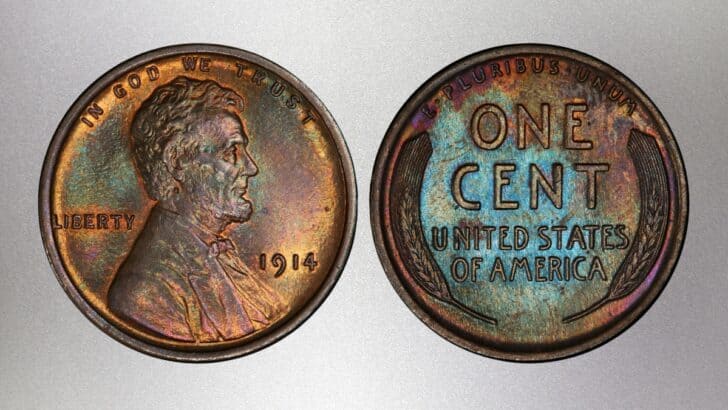The 1914 Lincoln wheat penny is an especially problematic one for collectors on a slender budget. Low mintage numbers combined with the age of the coin, and the heavy circulation that many coins saw, has led to prices for this particular year’s wheat pennies to be some of the highest of the entire series. Collectors may have to settle for specimens which are of a lower grade than that which they would prefer to own, or may have to forego any coin at all for long periods of time while waiting for suitable examples to appear on the market.
Production of the 1914 Lincoln Wheat Penny
The 1914 Lincoln wheat penny was not struck in large numbers. The production coming from the Denver Mint in that year was especially low, and is, in fact, the third-lowest mintage in the entire production run of Lincoln wheat pennies, coming in after the 1931-S penny, and the 1909-S VDB production, which lasted only a partial year. As is customary, wheat pennies struck in Philadelphia carry no mint mark. Those struck in Denver carry the mint mark “D.” Those pennies made in San Francisco carry the mint mark “S.”
| Date | Philadelphia | Denver | San Francisco |
| 1914 | 75,237,067 | 1,193,000 | 4,137,000 |
| 1914 Proof | 1,365 | 0 | 0 |
Values for the 1914 Lincoln Wheat Penny
The overarching factor driving the value of the 1914 Lincoln wheat penny is unquestionably scarcity. Out of 75,000,000 or so 1914 wheat pennies coined in Philadelphia, approximately 7,500,000 are thought to survive in all grades. For 1914-S pennies minted in San Francisco, the numbers are roughly 4,000,000 made and 400,000 survivors. Overall, the 1914-D wheat penny has roughly the same survival rate, of around 10%, but the low mintage number, of just over 1,000,000, and the low total number of about 120,000 surviving coins means that few appear on the market at any given time.
In discussing the value of the 1914 Lincoln wheat penny, an understanding of coin grading is absolutely essential. The 1914 penny is uncommon, and highly sought after. Tiny distinctions of grade can lead to price differences of hundreds or even thousands of dollars in value. As such, this is probably not a coin for a beginning collector to tackle, without either advice from a more experienced collector, or a thorough understanding of grades. There are many good resources for beginning collectors to learn about penny grading. In addition, finding a good reference book about Lincoln pennies would be a prudent first step.
| 1914 Penny Value Chart | |||
| Business Strike | Grade | ||
| Uncirculated MS64 | Uncirculated MS65 | Uncirculated MS66 | |
| 1914 1C BN | $108.00 | $162.00 | — |
| 1914 1C RB | $130.00 | $260.00 | $715.00 |
| 1914 1C RD | $390.00 | $910.00 | $3,000.00 |
| 1914-D 1C BN | $4,620.00 | $6,250.00 | $12,000.00 |
| 1914-D 1C RB | $5,500.00 | $7,000.00 | $26,400.00 |
| 1914-D 1C RD | $10,500.00 | $16,800.00 | $86,400.00 |
| 1914-S 1C BN | $715.00 | $1,500.00 | — |
| 1914-S 1C RB | $1,500.00 | $2,810.00 | $6,250.00 |
| 1914-S 1C RD | $2,500.00 | $10,300.00 | $68,400.00 |
| Proof Strike | Grade | ||
| PR65 | PR66 | PR67 | |
| 1914 1C BN | $1,090.00 | $1,750.00 | $3,880.00 |
| 1914 1C RB | $1,250.00 | $2,060.00 | $7,500.00 |
| 1914 1C RD | $1,880.00 | $2,810.00 | $16,800.00 |
For all except the very lowest grades of 1914 wheat pennies struck in Philadelphia, prices for any Lincoln wheat penny will be high, in the tens or even hundreds of dollars for circulated examples, and in the hundreds or thousands of dollars for even the lowest grades of uncirculated coins.
The extent of the scarcity and high prices can best be realized by considering this specimen, of a 1914-D wheat penny, sold at Heritage Auctions in August 2023. Ordinarily, collectors would not look twice, and many dealers might hesitate before even offering it. It has been graded F-12. But at some point in the past, it has been both cleaned, and “whizzed,” scratched with a hard brush in an attempt to give it a newer look and a higher grade. It is also described as damaged. Nevertheless, it fetched a price of $105.
Values for 1914 Wheat Pennies

Prices for 1914 wheat pennies from Philadelphia are the lowest of the series, although the overall scarcity of the coin doesn’t mean that these can be considered inexpensive and accessible to beginning collectors. This may prove a challenge for beginners which is best left for later.
In the circulated grades, a purchaser can expect to pay $0.75 for a 1914 wheat penny graded “G-4,” or $2.15 for a 1914 wheat penny graded “F-12.” Prices rise from there. An “XF-40” 1914 Lincoln wheat penny can be found for approximately $20, and an “AU-55” 1914 wheat penny for about $45. Brown uncirculated coins will cost between $75 and $175.
Except at the lowest grades, these are not coins for the little blue penny folder.
In the highest uncirculated grades of MS-67 or better, the 1914 penny is the rarest of the Lincoln wheat pennies. Even in 2005, a 1914 Lincoln penny graded MS-67 sold for $48,300. The auction notes from Heritage Auction stated that the national certification services knew of only three such examples.
A 1914 Lincoln wheat penny, graded MS-66 RD, fetched $5,760 at Heritage Auctions in November 2023.
Values for 1914-D Pennies
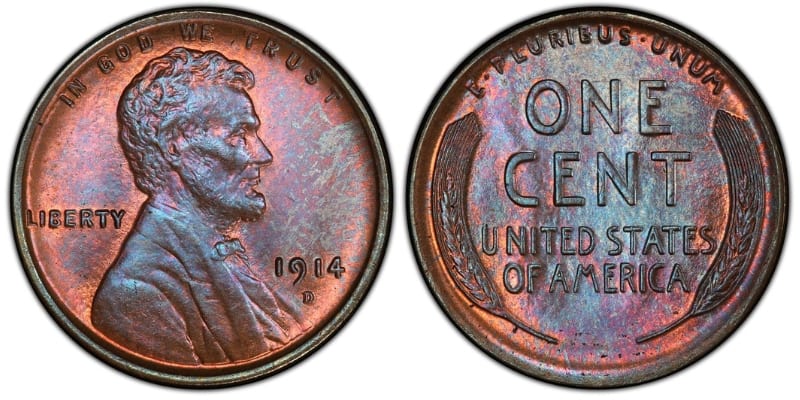
This coin is simply rare; there is no other way to describe it. Even circulated examples are routinely taken to auction, where they command high prices. Here are some specific examples:
In September 2023, a VG-10 1914-D wheat penny was sold at auction for $198.
In November 2023, an F-12 1914-D wheat penny went to auction, and fetched $240.
In December 2023, a 1914-D wheat penny, graded XF-45 sold for $1,320 at auction.
Uncirculated specimens also command extraordinary prices when they come onto the market. Even sub-par specimens will be sellable. Thus, in November 2023, a 1914-D wheat penny, described simply as “cleaned” and “uncirculated.” sold for $1,440. Also in that month, a 1914-D wheat penny graded MS-63 RB sold for $4,320 at the same auction.
In February 2016, a 1914-D wheat penny, graded MS-66 RD went for sale at Heritage Auctions. It sold for $81,075. The auction notes pointed out that while the 1909-S VDB penny has much more fame, and is more highly sought by collectors, in terms of scarcity in the higher grades, the 1914-D penny was actually much the rarer coin. Only ten examples of 1914-D wheat pennies graded MS-66 RD were known, and no 1914-D pennies of higher grade were known. The auction service also provided some notes on the provenance of the high grade 1914-D specimens, attributing them either to a group of about 700 coins that was broken up in the 1950’s, or to some penny rolls found during the 1970’s. Those details are the sort that can keep collectors living in hope for some time.
Detecting 1914-D Penny Counterfeits
Given the rarity of 1914-D wheat pennies in any condition, it is natural and to be expected that unscrupulous individuals should attempt to counterfeit or otherwise “palm off” poor specimens as more valuable coins. We have already seen one such attempt in the very first example given in this article, of a cleaned and brushed or whizzed penny. After full disclosure of the defects, such a piece still attracted a bid of over $100 at open auction. Less honest dealers may not always make that disclosure. When considering purchasing a 1914-D Lincoln wheat penny, deal only with reputable dealers and consider seeking authentication from outside sources or other dealers whenever possible.
Here are some points to look for in detecting counterfeit 1914-D pennies:
Mint mark styles changed over time in the U.S. Mint. Counterfeiters may not always pay attention to that fine detail, and so compare pictures of a known 1914-D penny, showing a close-up of the mint mark, to the specimen mint mark. A stronger magnifying glass than the usual loup or 4x magnifying glass usually used for grading may come in handy for this comparison.
If the counterfeiter attempts to add a mint mark, it may be placed in the wrong position. Double-check the location of the mint mark, and not just its style.
One common way to make a counterfeit 1914-D penny is to begin with a 1944-D penny, and scour out the first “4”. Thus, the process would be: “1944” –> “1914”. The problem for the counterfeiter is that scouring out part of the 4 leaves an unnatural gap. The result thus looks more like: “19 14.” Again, careful magnification and examination can help reveal such forgeries. There may also be a faint outline of the remaining portion of the 4 faintly visible under close inspection.
An outright fake can be made by casting or other processes. These may have a weak impression, as a proper coin die used at the Mint creates a bold, sharp image, even if it becomes worn over time, while creating a mold will often leave a fuzzy or ragged impression. It is also very possible that the counterfeiter will create a forgery either of the wrong size, or the wrong weight. Compare suspect coins to the technical details described below.
Values for 1914-S Pennies
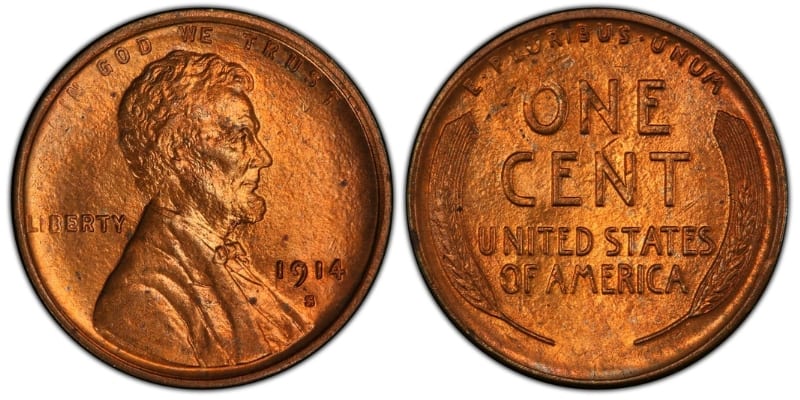
While the San Francisco Mint produced more pennies than the Denver Mint in 1914, specimens are still scarce. Prices are correspondingly high.
In the circulated grades, collectors can expect to pay a minimum of $15 for a heavily worn 1914-S Lincoln wheat penny graded “G-4,” and $25 for a slightly better 1914-S penny graded “F-12.” Still nicer coins, graded “XF-40,” or “AU-55” will not likely be available for under $100, and perhaps not for $150.
Uncirculated, mint-state 1914 wheat penny specimens are correspondingly expensive. In October 2023, Heritage Auctions sold a 1914-S penny, graded MS-63 BN for $524.40.
A much nicer coin, a 1914-S wheat penny graded at MS-65 RD, sold for $9,000 in November 2023. The auction catalog at Heritage Auction said that only a “few dozen” 1914-S pennies survive at that particular grade and finish level. This particular penny had a small carbon spot near the U in “UNUM” but otherwise retained its bright red “new penny” look.
Prices for the 1914-S can go even higher, and can rival those of the 1914-D wheat penny. In 2008, a 1914-S MS-66 RD sold for $83,375. The auction notes pointed out that coins retaining the original red color were extremely rare, and was one of just three examples known to exist.
Were any 1914 Proof Lincoln Wheat Pennies Produced?
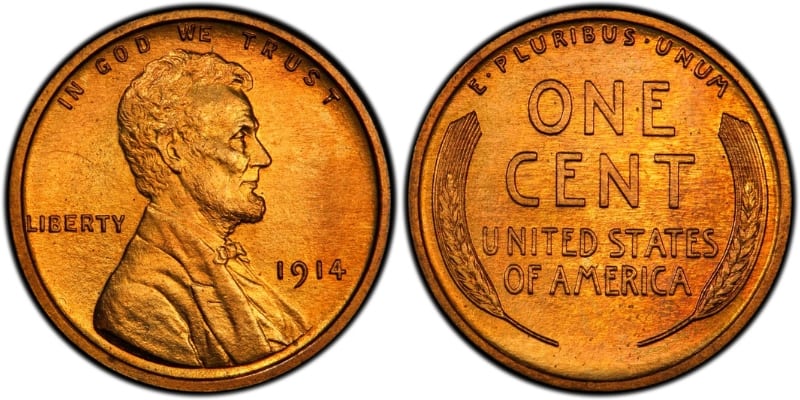
Proof coin production for the Lincoln wheat penny was low when it was first introduced, and fell steadily, until the U.S. Mint discontinued all proof coin production in 1916, stating that there was a lack of collector demand. Proof coin production would not be resumed until 1936. The Philadelphia Mint created fewer than 1400 proof Lincoln pennies in 1914.
Compounding the scarcity, the Mint packaged proof coins in a chemically reactive paper in this period, which, over time, tended to damage the finish of the specially made coins. Under the circumstances, and given the price of other specimens of 1914 Lincoln wheat penny, the price of proof pennies from this year is quite high.
In September 2023, Heritage Auctions sold a PR-66 RB Lincoln wheat penny for $3,120. The auction notes seem to indicate that there are fewer than 75 proof pennies even of this grade or better known to the main grading certification services. This price was not an outlier; two months later, Heritage Auctions sold a PR-65 RB Lincoln wheat penny for $1,260. Even a completely oxidized 1914 Lincoln wheat penny proof, graded at PR-66 BN, with no vestige of a mirror-like finish whatsoever, sold for $1,920 in July 2023.
Only a handful of coins from the era have retained anything like their original appearance, and these command extraordinary prices on the rare occasions on which they appear for auction. In April 2008, a Lincoln wheat penny graded as PR-68 RD sold for $126,500. The auction notes indicated that only one other proof coin from 1914 had so high a grade, and only one other proof penny, from 1909, could be said to match it.
Error Values for the 1914 Lincoln Wheat Penny
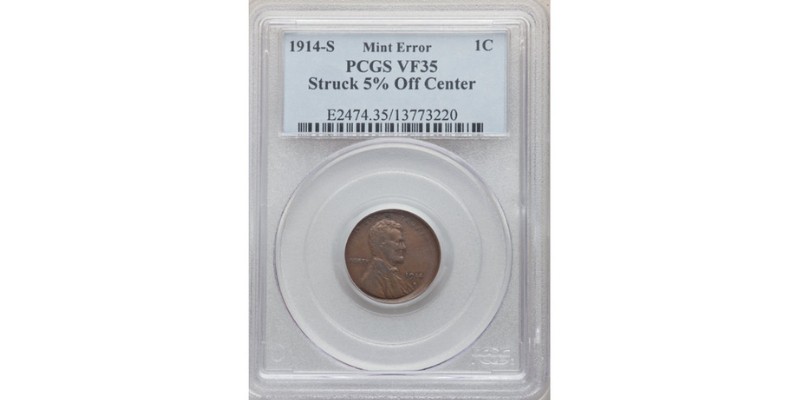
It will not be any surprise to learn that, given any other specimen of 1914 Lincoln wheat penny commands a good price, the few error coins that have appeared at auction recently also command good prices. These have been mainly if not exclusively off-center strikes, as there are no known die-varieties for the 1914 wheat penny cited in the Cherrypickers’ Guide to Rare Die Varieties of United States Coins. In September 2019, a 1914-S Lincoln wheat penny, graded VF-35 and struck 5% off-center, sold for $750. At the same time, a 1914 Lincoln wheat penny, graded MS-63, and struck 15% off-center sold for $372. More recently, in January 2022, a 1914 Lincoln wheat penny, graded MS-64 RB, struck 10% off-center sold for $198.
Technical Specifications of the 1914 Lincoln Penny
Given the value of 1914-D and 1914-S Lincoln wheat pennies, and the occasional appearance of counterfeits, actually weighing and measuring a prospective purchase may not be the most awful idea, or even an especially paranoid one. The Lincoln wheat penny should weigh 3.11 grams, and it should be 17 millimeters in diameter. It is a bronze coin made from 95% copper and 5% zinc and tin, not a pure copper coin.
The original design was created in 1909, by Victor David Brenner, who was hired as part of a larger effort to upgrade the artistic appearance of American coins generally, which was a project especially dear to the President of the era, Theodore Roosevelt.
Summary
The 1914 Lincoln wheat penny is a particularly rare coin, avidly sought by collectors, who bid prices up at all but the lowest grades. Beginning collectors should tread very carefully when considering purchasing a wheat penny from this year, and prices are likely to be very high for all but the wealthiest collectors. The 1914 wheat pennies are a key date in any penny collection, and any purchase should be carefully considered and intentionally made.
